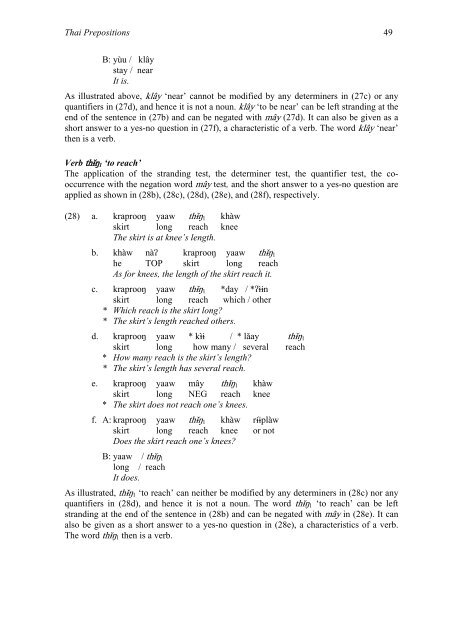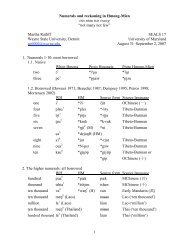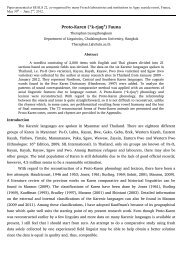proto-southwestern-tai revised: a new reconstruction - seals 22
proto-southwestern-tai revised: a new reconstruction - seals 22
proto-southwestern-tai revised: a new reconstruction - seals 22
Create successful ePaper yourself
Turn your PDF publications into a flip-book with our unique Google optimized e-Paper software.
Thai Prepositions 49<br />
B: yùu / klây<br />
stay / near<br />
It is.<br />
As illustrated above, klây ‘near’ cannot be modified by any determiners in (27c) or any<br />
quantifiers in (27d), and hence it is not a noun. klây ‘to be near’ can be left stranding at the<br />
end of the sentence in (27b) and can be negated with mây (27d). It can also be given as a<br />
short answer to a yes-no question in (27f), a characteristic of a verb. The word klây ‘near’<br />
then is a verb.<br />
Verb thɨ̌ŋ1 ‘to reach’<br />
The application of the stranding test, the determiner test, the quantifier test, the cooccurrence<br />
with the negation word mây test, and the short answer to a yes-no question are<br />
applied as shown in (28b), (28c), (28d), (28e), and (28f), respectively.<br />
(28) a. kraprooŋ yaaw thɨ̌ŋ1 khàw<br />
skirt long reach knee<br />
The skirt is at knee’s length.<br />
b. khàw nàʔ kraprooŋ yaaw thɨ̌ŋ1<br />
he TOP skirt long reach<br />
As for knees, the length of the skirt reach it.<br />
c. kraprooŋ yaaw thɨ̌ŋ1 *day / *ʔɨ̀ɨn<br />
skirt long reach which / other<br />
* Which reach is the skirt long?<br />
* The skirt’s length reached others.<br />
d. kraprooŋ yaaw * kɨ̀ɨ / * lǎay thɨ̌ŋ1<br />
skirt long how many / several reach<br />
* How many reach is the skirt’s length?<br />
* The skirt’s length has several reach.<br />
e. kraprooŋ yaaw mây thɨ̌ŋ1 khàw<br />
skirt long NEG reach knee<br />
* The skirt does not reach one’s knees.<br />
f. A: kraprooŋ yaaw thɨ̌ŋ1 khàw rɨ́ɨplàw<br />
skirt long reach knee or not<br />
Does the skirt reach one’s knees?<br />
B: yaaw / thɨ̌ŋ1<br />
long / reach<br />
It does.<br />
As illustrated, thɨ̌ŋ1 ‘to reach’ can neither be modified by any determiners in (28c) nor any<br />
quantifiers in (28d), and hence it is not a noun. The word thɨ̌ŋ1 ‘to reach’ can be left<br />
stranding at the end of the sentence in (28b) and can be negated with mây in (28e). It can<br />
also be given as a short answer to a yes-no question in (28e), a characteristics of a verb.<br />
The word thɨ̌ŋ1 then is a verb.





